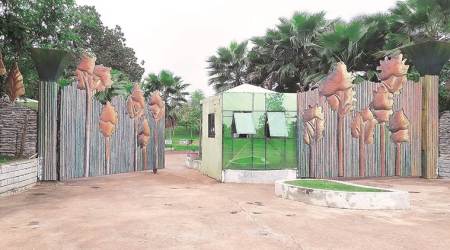 Rag pickers look for reusable materials at a garbage dump littered with polythene bags in Lucknow. (AP Photo/Rajesh Kumar Singh)
Rag pickers look for reusable materials at a garbage dump littered with polythene bags in Lucknow. (AP Photo/Rajesh Kumar Singh)
The challenge of solid waste management in Indian cities is now receiving belated but welcome attention and about time too. Rising incomes and changing lifestyles are generating more waste and of a different kind, but we are yet to set up systems to deal with the build-up. Swachh Bharat Mission provides an opening, but much more needs to be done on the ground.
Waste was not such a problem in India until the 1970s. In our rural areas, food discards were returned to the soil. Food leftovers were fed to animals and the cattle-shed wastes were thrown in a pit to decompose and become manure for the next planting season. This returned both NPK (nitrogen, phosphorus, potassium) nutrients as well as micronutrients to the soil for healthy crops.
Urban food discards were also recognised as a potential resource, not a waste. In Portuguese Goa, bullock carts would move from bungalow to bungalow, collecting kitchen leftovers for on-farm composting. This was the earliest Indian version of doorstep waste collection. In big cities like Bangalore, farmers would bring their produce to town for early-morning auctions, then move to the cement-ring waste bins at street corners and empty them to take back home and produce manure. In fact, they would fight over collection rights for this fertile resource. This age-old practice kept Indian soils rich in carbon, up to 4 per cent.
All this changed with the beginning of the plastic era in the 1970s. Some readers will recall how plastic bags were initially cherished as a useful item for hoarding in our homes, carefully taken out for re-use when needed. As the bags became more common, poor quality, and disposable, we began throwing them away into our kitchen waste-bins. When farmers took such mixed waste to their farms, the fields wore a non-biodegradable plastic film, preventing rain from entering the soil and keeping seeds from germinating through them — an example of negative urban-rural connectivity.
Two useful resources, biodegradable waste and plastic, when mixed together, became waste and remained uncollected. Add to this the mixing of other dry waste and the debris from construction and demolition down the supply chain of waste, and this assorted mixed waste presents a major management challenge for the municipal authorities.
City managers forced to deal with this growing waste began collecting and dumping the same outside the city limits. Since nearby farms and villages did not want this mixed waste either, it often ended up along the sides of roads leading out of town. These convenient ribbons of no man’s land were not managed or defended by anyone. When even these filled up with ridges of waste, cities found larger areas outside to create mini hills of mixed waste.
These rotting heaps of waste, denied oxygen from the air, emit methane (CH4) which is over 21 times more potent as a heat trapping gas than carbon dioxide. They generate ammonia which smells like dirty urinals and nauseating hydrogen sulphide which smells like rotten eggs. The airless heaps also produce leachate, a black liquid oozing out from the waste. Imagine a rotten tomato in a plastic bag which turns to a smelly liquid, unlike a similar rotten tomato which is left in the open air and dries to powder. This example illustrates the importance of aerating the waste heaps.
Waste heaps without adequate exposure to air take 25-30 years to slowly decompose, continuously releasing methane and leachate. This leachate seeps down into the soil and contaminates open wells and after a longer time even reaches and pollutes bore wells through deep natural water channels. When waste is dumped in low-lying areas or quarry pits, the hydrostatic pressure of so much water-logging forces the leachate into water veins even faster. There is no way to treat this deep underground contamination, which makes wells and bore wells unfit for drinking and even for irrigation for decades.
Households need to be made to stop mixing biodegradable waste with dry waste (paper, plastic, glass, etc) and keep hazardous domestic waste completely separate. The segregation of waste at source into “wet” (compostable), “dry” (recyclable) and “sanitary” (disposable diapers and sanitary napkins) categories is now compulsory for all citizens of India in the Solid Waste Management Rules 2016. However, residents typically complain that the waste is mixed again in the door-to- door collection process. While demanding high standards for door-to-door collection, we must continue with our discipline at home.
In 2003, Suryapet in Andhra Pradesh was the first Indian city to process its wet waste, recycle its dry waste and leave nothing for landfilling. Vengrula in Maharashtra and Tirunelveli in Tamil Nadu are the latest of over 20 urban local bodies to achieve near zero waste to landfill. The wet waste needs to be collected and processed daily, either composted at home or taken to nearby locations for decentralised composting or biogas production or taken to centralised plants. At the very least, the waste needs to be stabilised as described below. The correct way to manage fresh waste is to expose as much of it to air as soon as possible. Worldwide, the standard way of doing this is to unload the waste in windrows, not high heaps.
Windrows are long low parallel heaps of waste, not more than two metres high, which are designed to achieve the best conditions for aerating the waste. Only parking-lot type management is required to guide incoming vehicles on where and how to unload their waste, moving slowly forward and leaving the waste behind in a long row. Enough space is left between rows for a lifting tractor or earthmover to drive through and turn the waste in the windrow.
The outer aerated waste should form the inner core of a new windrow, and the airless centre of the old heap now on the outside. Weekly turning of the waste, repeated at least four times, ensures that all parts of the waste are fully decomposed, like leaves on a forest floor, turning dark brown and with a sweet earthy smell. The process can be speeded up by the addition of composting bio-cultures (fresh cow dung or substitutes available in the market).
Fresh waste windrows heat up inside, to about 55°C to 60°C in three to four days. After four turnings, there is about 40 per cent weight loss as moisture content declines and also about 40 per cent volume reduction. After this, no leachate or methane or smelly gases are released, and this fully stabilised waste is called compost, rich in microbes as well as humus, both wonderful for soil vitality.
This bio-stabilising of biodegradable waste makes a city fully compliant with the SWM Rules 2016. Screening makes it more farmer-friendly and helps move useful fractions offsite to ensure continued long-term use of the same site for waste processing. The recycling of existing waste management space is one of the biggest advantages of waste stabilising and frees local bodies from the constant search for new sites to pollute and new urban rural battles over locations for waste processing.
Ahluwalia is chairperson, ICRIER, Delhi, and former chairperson of the high-powered expert committee on urban infrastructure and services. Patel is member, Supreme Court committee on solid waste management

